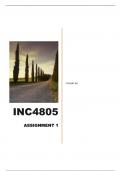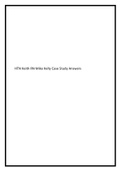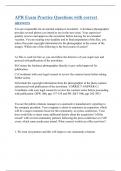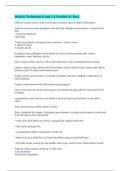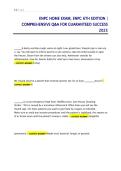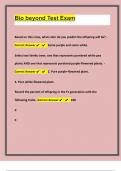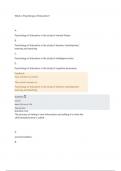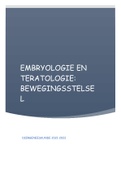What makes
Factors leading a species
to loss proneof biodiversity
to extinction? The IUCN Red list- what does Vulnerability it do of tropical rainforest- most important ecosystem in
Narrow Naturalgeographical
disasters:range- volcanic I f aeruptions,
species only earthquakes
lives in one (Haiti
place2010),
and thatfloodsplace (Yangtze
is RiverMonitors
floods inthe China
state thatof left
the world’s regards speciesof biodiversity.
through the Red List of Threatened species and supports
damaged 14 millionor destroyed the habitat Environmental
people homeless). has gone. It may be possible
disasters to keepthough
are usually breeding to be caused theby Millennium
human activity Ecosystemand Assessment as well as educating the public, advising governments and
populations of the species in the zoos or reserves but that is not the real solution. assessing new world heritage sites.One hectare may have 300 species living on it.
Small 3.3 would
Threats
population
include loss of tropical rainforests on a massive scale and oil spills. The major cause of loss of
to Biodiversity
size or declining numbers- low genetic diversity- a small pop has a The Red List determines the conservation Estimation of species
biodiversity istotal
loss number
of habitat. In moston parts ofplanet
the world humans destroyed or changed Producestatus aboutof40% a species based on
of the oxygen several
that animals criteria: population
use- lungs of earth.
smaller Estimates geneticof the diversity and is less of species
resilient tothe change, cannot vary considerably.
adapt. ‘LivingThey dead’ areorbased onthe
size,
original habitat.
World
degree of Biodiversity
specialization, distribution, reproductive
potential Only
and between
behavior, 1.4-1.8
geographicmillionrange
species
E.g. in Philippines, sri lanka and Bangladesh where humanissues population levels are high, we have lost most of the Malaysia has one of the richer rain forests: 8,000 flowering plantand
mathematical models,
become extinct. E.g snow leopard, tiger. which are influenced by classification and lack of finance for
degree fragmentation,
of A conservative estimate
quality of of species
habitat, trophicalive level and the of organisms
probability have
of been
extinction. described
wildlife habitat resulting
and mostinofmany the primary species of 1,400 genera including 155 genera of the huge
Low scientific
populationsresearch, densities and habitatsrainforests.
large territories- and groups
habitat being significantly
fragmentation under-
can restrict today is aboutspecies 7 million species excluding and named, solevels
are ‘known to to their
Fragmentation of habitat- large area that is divided into a patchwork of fragments, The Red List of threatened are objective
Dipterocarp lists of
trees, species
which has under
enormous varyingcommercial of threat
importance.
recorded. separated from each
bacteria. science’.
species territory. Might not be able to find each other to mate. survival. Data gathered scientifically Theyon global
covered scale
14%and speciesland
of Earths under threatinare
surface 1950,putbut under
have a been
Few other
Thepopcurrent byrate
roads, factories,
of species loss fields
is faretc. the fragments
greater are isolated in a modified or
to degraded landscape act as
of the species- if they only have one today
or twonow than
populations in recent past,their
left that’s dueonly category to assess Most are animals
the relative danger andofare
cleared terrestrial.
extinction.
by humans There
at is also
quick
How
a red
rates.
welistreach
Some of the estimate
extinct
estimate and extinct
that they
of species
willI nbe
islands.human
increased Higherinfluence.
edge to area The ratios
human asactivities
the fragments that get smaller
cause species and have greater
extinctions fluctuations to light, water
include depends on species. Easier to see
chance of survival. One pop wiped out and a species is gone- lemurs. the wild species. The 2/3rdslistsare areinregularly
thegonetropics,
updated mostly and inform gov policies
completely in next 50 years due to human activity. on trade in endangered
and destruction,
habitat humidity at the edge than
introducing the middle.
invasive species, Invasion
pollution,of habitat by pest species
overharvesting and or humans increases and there
hunting. large than small. Big, furry grab our
A large body- large top predators are rare. Tend to have large ranges, low population species and conservation tropical measures.
rain forests.50% TheofIUCNEarths Red List has
timber 40,000 rainforests
in tropical species on itand andtimber
aboutis40% nextif
TheisInternational
densities a possibility that
Union domestic
for and
Conservation wild species
of Nature come
and need a lot of food. May be danger to humans and are hunted for sport. (IUCN)into contact
publishes and
data spread
in The diseases
Red list between
of populations.
50%
these are listed as threatened. of forests have been cleared by attention.
biggest resource after oil in the world today.
Low Threatened
Pollution- Species
caused inbyseveral
human categories. Factors
activitiesslowly
can degrade used to determine
and destroy thethe
habitats conservation
and make status them unsuitable tocriteria
supportare:
humans= clearing Most mammals and birds are known.
reproductive potential- reproducing and infrequently means The IUCN Red list Atlogging
least 2 aboutbillion1m humans live in the wet tropics and many of these
of species
the rangeinclude:
of population
species that a size, degree
pristine of
ecosystem specialization,
can support. distribution,
These reproductive
include: Easier to find plants as they cannot
population takes a long time to recover. E.g whales. 1. Extinct (EX) - square when there meters is noevery
rely 5-10years.
reasonable
on doubt from
rainforests that the last individual
subsistence has died.
agriculture. A lowE.g.density
A taxonofis
potential 1.and behavior,
Local geographic
pollution, for range
example and degree
spraying
Seasonal migrants- species that migrate have it tough. Long migration routes and a of of fragmentation,
pesticides may driftquality
into of
wild habitat,
areas, oil spills may kill many
Manywhen countries have no primary move.
presumed Extinct exhaustivehuman surveys
pop in known and/
is sustainable or expected
as they clear small habitat
partshave failedand
of forest to
trophic level
hazardous and
sea the
journey, birds
theyprobability
and
needsmallerthe of extinction.
marineatspecies.
habitats both end of the migration route. If one forests.
record an individual.
Many smaller organisms such as
grow crops for a few years then move on to the next area once the
isTropical biomes
2. they contain
Environmental some of the
to pollution most globally
by emissions biodiverse
from factories areasand andtransport
their unsustainable
can lead insects, fungi, bacteria have not been
destroyed get there find no food or habitat. 2. to acid deposition
Extinct in the wild or (EW) - when it is known
sail exhausted- only shifting
to survive in cultivation,
cultivation. in captivity
This works as long orasasthere
a is
exploitation results in massive losses in biodiversity and their ability to perform globally
Poor dispersers- species that cannot
photochemical smog. move easily to new habitats. Plants can only naturalized population well outside enoughthe timepast all the forestsfound,
forrange. identifiedbefore
to regenerate or named.it’s used again.
important ecological or services.
rely on seed 3. dispersal
Run- off ofvegetative
fertilizers into growth to move.can
waterways Flightless birds.
cause eutrophication, toxic chemicals canOne
3. Critically way of finding
engendered
accumulate in (CR) and -identifying
when insects
it is considered
Increasing pop pressure Extinction
to besand facing
lossanofextremely
forests tohigh risk of the
clearance,
Most tropical biomes occur requirements-
in less economically developed
panda countries and left)
therefore there is Beetles
Specialized feeders food or niche
chains. The giant (about 2,000 extinction in the(Coleoptera)
wild. are the group
forests do notmost fully regrow beforeWhenit aisspecies
clearedceasesand there to exist
is a after
a conflict between exploitation, sustainable development and conservation. identified and named species. the last individual in that species dies,
mostly eats 4. Endangered (EN) - when it is facing a very high riskof ofnutrients
extinctionand in the wild.
4. bambooClimate shoots
change in forests of central
alters weather China. and shifts biomes away from the
patterns equator. gradual degradation biodiversity.
Edible to humans and herding together- Overhunting and over harvesting 5.
Vulnerable Beetles(VU) are
- wheninsectsit isand
facinghave a about
high risk 25%of of
extinction is
in a
thenatural
wild. process.
Overexploitation- has escalated as human populations have expandedcan and technology has allowed us to get
all named species
so up
It is estimated that it takes 1,000 years for the biodiversity of the
to 2beenmillion. Eventually allbutspecies
eradicate a species quickly, especially if that species lives in large groups, shoals of 6. Near Threatened (NT) - when it has
primary forestevaluated against
to be recovered. the criteria, doesbecome
not qualify extinct
for
better and The better at catching, hunting and harvesting. The Grand Banks off Newfoundland were
1. one One ofwaytheof finding and isidentifying insects or is and
Extinct
fishspecies-
or passenger dodo
pigeons. With human technology is easy to exploit this species. critically endangered etc., but close to qualifying
Rainforests are diverseforbecause ofthe
likely toaverage
the qualify lifeaspan
for
many ecological of
threateneda species
niches they
Description: richest large fishing grounds
flightless birdin of the world
endemic but
to the are now
island fished so
of Mauritius. out. If we exceeded the maximumcategory sustainable yield
isin‘fogging’
the of
future.the canopies of rainforest treesof heat, light, varies.
Tigers- body parts are used traditional Chinese medicine, demand is very high. provide. High levels and water are present all year
Ecological anyrole:species,
No then
major the population
predators on is not
Mauritious
Island organisms- can be vulnerable to extinction. Depending on the size of thesustainable.
so the dodo As personal
had no wealth
need to increases
fight. The people
dodo 7. want
Least newwith
concern and short
(LC) lived
- when insecticides.
it is widespread and abundant.
and this means that photosynthesis Most animals
is rapidhave and not a species
limitedlifespan
by the
wasisland: different,
a ground nesting
populations exoticbird.
tendpets.t beVictims
small,ofislands this trade
haveinclude many primates,
a high degree of endemic birds and reptiles.8. Data
species, 2. deficient
Then the (DD) organisms
- when there fall
lackout of thematerials.
isofinadequate
raw treesinformationof toonemake million
a direct,years.or indirect,
genetic
Pressures: Introducing
Indiversity non- native
1505 Portuguese
tends to be species-
sailors
low canunique
indiscovered
small drastically
Mauritious
island upset and a natural ecosystem.
used it islands
populations, as tend Humans
a restocking to point have done this
on assessment andthrough
areitscollected
of andFour
risk of extinction counted based
layers and onthe
of forThe
its distribution
forest allow and/rate
many or at which
pop
different status. extinctions
habitats occur is
and niches
theirbevoyages colonization
vulnerable to get of
to spiecies different
introduction from of countries,
Indonesia.
non-native bringing
Atepredatorstheir own
dodo as atosource crops
whichof or
they life
fresh
have stock.
meat. Sometimes
Island used9.
no defense the species numbers
is introduced are
as a Not evaluated (NE) - when it has extrapolated. andnot these been areevaluated
filled withagainst not constant
diversecriteria. and is made
species. All year round growth up of the
penal by
colony accident
(jail) and or escapes
rats and
mechanism. The dodo is a classic example of this. from
pigs gardens
and monkeys or zoos.
were introduced. They ate dodo eggs and Factors that help maintain biodiversity background
means that food can be found at any time of the year. The lack extinction rate and mass
of
humans used The Sometimes
it forminimum
sport andviable it works:
food. Monkeys potatoes
population sizefrom
stole theirthe
that Americas
iseggs,
needed forto
Conversion Europe.
of forest
a species to plantations
to survive Inertia- property of andisturbance ecosystem over delaythe or years suggestsextinctionsthat when
the systema sudden loss time
has had of
also destroyedin their
theSometimes
habitat.
wild it is athat
Extinct
is a figure disaster:
by 1681. Dutch
scientists and Elm disease came from
conservationists imported
consider. Depends American logs to Europe resistand change when subjected to become to more
a complex. species occurs in a relatively short
Consequencesonofmay decimated
disappearance- elm
factors e.g. genetic populations.
icon fordiversity.
its apparent stupidity, no fear of humans as never disruptive force. The fast rate of respiration and time.
decomposition means that the
feared Currently
Spread
predators. of disease-
Few skeletons may decrease
remain biodiversity.
‘dead as a dodo’. Diseases of domesticated animals can Recovered
spread to species-
Limiting
wild speciesAustralian
factors- saltwater
If the abiotic crocodile
factors
endangered species- Rafflesia forests appear to be very fertile with high levels of biomass in
Description: can grow
required up to
for life5marelong. It is bulky reptile with a broad snout. It lays up to 80 eggs each
available
Current and viceThere
Description:
extinction versa,
ratesisparticularly
15-19 species if population
of this tropicaldensities are high.
parasitic plant.InAll zoos, disease
of which areis a constant threat where species standingincrop. But most nutrients The are heldIUCN in the plants, not the
are kept close together. Diseases are tend to be species specific, but if they mutate year
they which
can take
infect up
abundance
across to 3
themonths
(water, to hatch.
nutrients, The crocodiles
light, co2) if take 15purpose
years toof mature. Red WasListlisted as
found in the jungles of Southeast Asia.
We think that the current extinction rate is about 100 species per million species per year. soil or leaf litter Once the plants
CITES are
The which cleared or
world conservation burned fertility
protected
swine flu isspecies in Australia
one changes in likelyinto 1971, and is protected under
still maintain banned tradeunion. in
E.O species
Ecological Wilson, barrier
Role: Single
biologist and thisHarvard,
sexed,
from isandan ever- present
pollination
thinks must
that threat. E.g. Arate
thebecurrent
carried swine
outof flu outbreak
when the plants
extinction inare
2010-
is 1,000 times
endangered
endemic
animals.
reduces rapidly because the heavy rainfall washes
International agency.the nutrients
inthe pigs
bloom. and
background can
Therefore, sometimes
rateaand male pass from
anditsa caused
that female bypigs
mustto humans.
humanbothactivities.
be ready for pollination
He suggests thatat 30-50
the per biodiversity. and soil away and the vegetation The is not there
union’s to lock uptothe
mission
Ecological role: The habitat
Stages of the saltwater
of succession-later stages crocodile is estuaries, swamps and river.was Nests areinfluence,
built
same
centModern
time.
of species The agricultural
seeds
could are practices-
dispersed
be extinct withinreduce
by 100 biodiversity
small squirrels and
years. with monocultures,
rodents and they must genetic engineering and pesticides. nutrients norare to more
protect the soil. encourage and assist societies
on river banks in heap of leaves.
resilient and stable than younger The eggs are food for goannas, phytons, dingoes and other small
reach TheFewer
a ‘host’
rate isand fewer species
farvine.
greater in someare grown
areas commercially
which are called hot andspots.
more Species
pest species are not aredistributed
removed.
animals. Older crocodileswhich eat young crocodiles, mud crabs, sea snakes, throughout turtletheeggs world
andto conserve
catfish. Babythe
Pressures:
around the Very
earth,vulnerable because they
but concentrated needareas.
in some specific Upconditions
to 50% of to surviveand
animals andplants
carryare in ecosystems are more vulnerable. integrity and diversity of nature and
crocodiles eat tadpoles, crabs and
Complexity of ecosystem- complex food fish. Top predator.
out
onetheir
of the lifeworld’s
cycle. They are vulnerable
30 hotspots due to deforestation
which together make up to 2% andoflogging
the land which
area on earth.Pressures: to ensure
was overexploited forlikely
skin, to meat, and body parts through illegalthat any use
hunting, of natural
poaching, and
destroy
These areas their habitat.
are very Humans vulnerable damage
to habitatthemlossandand fewer manyplants means
species lessthem
within chance areofvery smuggling. Itchains. was
Niches are
hunted for sport.
be filled
Deliberately
if
killed because resources
of attacks is
on equitable
humans. and
breeding.
vulnerable to habitat loss and the species are mostly endemic (only found there). Tropical destroyed. Complex communities and
Method of restoringecosystems populations:
have a high sustainable
resilience. use of policy with ecologically
limited culling sustainable.
of wild populations,
Method
forests of andrestoring
coral reefs population:
are particularly In Sabah, Sumatraand
vulnerable andsome
Sarawak there
species areare rafflesia
more likely to ranching (collecting eggs and hatching from the wild and raising them in captivity) and closed- eye
sanctuaries.
become extinct There thanareothers.
many locating,
Those who protecting,
give value and to monitoring
humans or eat programmes
our crops being are morefarming ( maintain breeding adults in captivity and harvesting offspring at four years of age). The
set up. Education-
prone to extinction. there are ‘SAVE RAFFLESIA’ campaigns.
exploitation of farmed animals reduced the hunting of wild crocodiles. Visitors tour to see wild
crocodiles so they are now a valued species. This policy was supported by the Species Survival
Commission (SSC) of IUCN, but was accused by others of treating crocodiles inhumanly.
Factors leading a species
to loss proneof biodiversity
to extinction? The IUCN Red list- what does Vulnerability it do of tropical rainforest- most important ecosystem in
Narrow Naturalgeographical
disasters:range- volcanic I f aeruptions,
species only earthquakes
lives in one (Haiti
place2010),
and thatfloodsplace (Yangtze
is RiverMonitors
floods inthe China
state thatof left
the world’s regards speciesof biodiversity.
through the Red List of Threatened species and supports
damaged 14 millionor destroyed the habitat Environmental
people homeless). has gone. It may be possible
disasters to keepthough
are usually breeding to be caused theby Millennium
human activity Ecosystemand Assessment as well as educating the public, advising governments and
populations of the species in the zoos or reserves but that is not the real solution. assessing new world heritage sites.One hectare may have 300 species living on it.
Small 3.3 would
Threats
population
include loss of tropical rainforests on a massive scale and oil spills. The major cause of loss of
to Biodiversity
size or declining numbers- low genetic diversity- a small pop has a The Red List determines the conservation Estimation of species
biodiversity istotal
loss number
of habitat. In moston parts ofplanet
the world humans destroyed or changed Producestatus aboutof40% a species based on
of the oxygen several
that animals criteria: population
use- lungs of earth.
smaller Estimates geneticof the diversity and is less of species
resilient tothe change, cannot vary considerably.
adapt. ‘LivingThey dead’ areorbased onthe
size,
original habitat.
World
degree of Biodiversity
specialization, distribution, reproductive
potential Only
and between
behavior, 1.4-1.8
geographicmillionrange
species
E.g. in Philippines, sri lanka and Bangladesh where humanissues population levels are high, we have lost most of the Malaysia has one of the richer rain forests: 8,000 flowering plantand
mathematical models,
become extinct. E.g snow leopard, tiger. which are influenced by classification and lack of finance for
degree fragmentation,
of A conservative estimate
quality of of species
habitat, trophicalive level and the of organisms
probability have
of been
extinction. described
wildlife habitat resulting
and mostinofmany the primary species of 1,400 genera including 155 genera of the huge
Low scientific
populationsresearch, densities and habitatsrainforests.
large territories- and groups
habitat being significantly
fragmentation under-
can restrict today is aboutspecies 7 million species excluding and named, solevels
are ‘known to to their
Fragmentation of habitat- large area that is divided into a patchwork of fragments, The Red List of threatened are objective
Dipterocarp lists of
trees, species
which has under
enormous varyingcommercial of threat
importance.
recorded. separated from each
bacteria. science’.
species territory. Might not be able to find each other to mate. survival. Data gathered scientifically Theyon global
covered scale
14%and speciesland
of Earths under threatinare
surface 1950,putbut under
have a been
Few other
Thepopcurrent byrate
roads, factories,
of species loss fields
is faretc. the fragments
greater are isolated in a modified or
to degraded landscape act as
of the species- if they only have one today
or twonow than
populations in recent past,their
left that’s dueonly category to assess Most are animals
the relative danger andofare
cleared terrestrial.
extinction.
by humans There
at is also
quick
How
a red
rates.
welistreach
Some of the estimate
extinct
estimate and extinct
that they
of species
willI nbe
islands.human
increased Higherinfluence.
edge to area The ratios
human asactivities
the fragments that get smaller
cause species and have greater
extinctions fluctuations to light, water
include depends on species. Easier to see
chance of survival. One pop wiped out and a species is gone- lemurs. the wild species. The 2/3rdslistsare areinregularly
thegonetropics,
updated mostly and inform gov policies
completely in next 50 years due to human activity. on trade in endangered
and destruction,
habitat humidity at the edge than
introducing the middle.
invasive species, Invasion
pollution,of habitat by pest species
overharvesting and or humans increases and there
hunting. large than small. Big, furry grab our
A large body- large top predators are rare. Tend to have large ranges, low population species and conservation tropical measures.
rain forests.50% TheofIUCNEarths Red List has
timber 40,000 rainforests
in tropical species on itand andtimber
aboutis40% nextif
TheisInternational
densities a possibility that
Union domestic
for and
Conservation wild species
of Nature come
and need a lot of food. May be danger to humans and are hunted for sport. (IUCN)into contact
publishes and
data spread
in The diseases
Red list between
of populations.
50%
these are listed as threatened. of forests have been cleared by attention.
biggest resource after oil in the world today.
Low Threatened
Pollution- Species
caused inbyseveral
human categories. Factors
activitiesslowly
can degrade used to determine
and destroy thethe
habitats conservation
and make status them unsuitable tocriteria
supportare:
humans= clearing Most mammals and birds are known.
reproductive potential- reproducing and infrequently means The IUCN Red list Atlogging
least 2 aboutbillion1m humans live in the wet tropics and many of these
of species
the rangeinclude:
of population
species that a size, degree
pristine of
ecosystem specialization,
can support. distribution,
These reproductive
include: Easier to find plants as they cannot
population takes a long time to recover. E.g whales. 1. Extinct (EX) - square when there meters is noevery
rely 5-10years.
reasonable
on doubt from
rainforests that the last individual
subsistence has died.
agriculture. A lowE.g.density
A taxonofis
potential 1.and behavior,
Local geographic
pollution, for range
example and degree
spraying
Seasonal migrants- species that migrate have it tough. Long migration routes and a of of fragmentation,
pesticides may driftquality
into of
wild habitat,
areas, oil spills may kill many
Manywhen countries have no primary move.
presumed Extinct exhaustivehuman surveys
pop in known and/
is sustainable or expected
as they clear small habitat
partshave failedand
of forest to
trophic level
hazardous and
sea the
journey, birds
theyprobability
and
needsmallerthe of extinction.
marineatspecies.
habitats both end of the migration route. If one forests.
record an individual.
Many smaller organisms such as
grow crops for a few years then move on to the next area once the
isTropical biomes
2. they contain
Environmental some of the
to pollution most globally
by emissions biodiverse
from factories areasand andtransport
their unsustainable
can lead insects, fungi, bacteria have not been
destroyed get there find no food or habitat. 2. to acid deposition
Extinct in the wild or (EW) - when it is known
sail exhausted- only shifting
to survive in cultivation,
cultivation. in captivity
This works as long orasasthere
a is
exploitation results in massive losses in biodiversity and their ability to perform globally
Poor dispersers- species that cannot
photochemical smog. move easily to new habitats. Plants can only naturalized population well outside enoughthe timepast all the forestsfound,
forrange. identifiedbefore
to regenerate or named.it’s used again.
important ecological or services.
rely on seed 3. dispersal
Run- off ofvegetative
fertilizers into growth to move.can
waterways Flightless birds.
cause eutrophication, toxic chemicals canOne
3. Critically way of finding
engendered
accumulate in (CR) and -identifying
when insects
it is considered
Increasing pop pressure Extinction
to besand facing
lossanofextremely
forests tohigh risk of the
clearance,
Most tropical biomes occur requirements-
in less economically developed
panda countries and left)
therefore there is Beetles
Specialized feeders food or niche
chains. The giant (about 2,000 extinction in the(Coleoptera)
wild. are the group
forests do notmost fully regrow beforeWhenit aisspecies
clearedceasesand there to exist
is a after
a conflict between exploitation, sustainable development and conservation. identified and named species. the last individual in that species dies,
mostly eats 4. Endangered (EN) - when it is facing a very high riskof ofnutrients
extinctionand in the wild.
4. bambooClimate shoots
change in forests of central
alters weather China. and shifts biomes away from the
patterns equator. gradual degradation biodiversity.
Edible to humans and herding together- Overhunting and over harvesting 5.
Vulnerable Beetles(VU) are
- wheninsectsit isand
facinghave a about
high risk 25%of of
extinction is
in a
thenatural
wild. process.
Overexploitation- has escalated as human populations have expandedcan and technology has allowed us to get
all named species
so up
It is estimated that it takes 1,000 years for the biodiversity of the
to 2beenmillion. Eventually allbutspecies
eradicate a species quickly, especially if that species lives in large groups, shoals of 6. Near Threatened (NT) - when it has
primary forestevaluated against
to be recovered. the criteria, doesbecome
not qualify extinct
for
better and The better at catching, hunting and harvesting. The Grand Banks off Newfoundland were
1. one One ofwaytheof finding and isidentifying insects or is and
Extinct
fishspecies-
or passenger dodo
pigeons. With human technology is easy to exploit this species. critically endangered etc., but close to qualifying
Rainforests are diverseforbecause ofthe
likely toaverage
the qualify lifeaspan
for
many ecological of
threateneda species
niches they
Description: richest large fishing grounds
flightless birdin of the world
endemic but
to the are now
island fished so
of Mauritius. out. If we exceeded the maximumcategory sustainable yield
isin‘fogging’
the of
future.the canopies of rainforest treesof heat, light, varies.
Tigers- body parts are used traditional Chinese medicine, demand is very high. provide. High levels and water are present all year
Ecological anyrole:species,
No then
major the population
predators on is not
Mauritious
Island organisms- can be vulnerable to extinction. Depending on the size of thesustainable.
so the dodo As personal
had no wealth
need to increases
fight. The people
dodo 7. want
Least newwith
concern and short
(LC) lived
- when insecticides.
it is widespread and abundant.
and this means that photosynthesis Most animals
is rapidhave and not a species
limitedlifespan
by the
wasisland: different,
a ground nesting
populations exoticbird.
tendpets.t beVictims
small,ofislands this trade
haveinclude many primates,
a high degree of endemic birds and reptiles.8. Data
species, 2. deficient
Then the (DD) organisms
- when there fall
lackout of thematerials.
isofinadequate
raw treesinformationof toonemake million
a direct,years.or indirect,
genetic
Pressures: Introducing
Indiversity non- native
1505 Portuguese
tends to be species-
sailors
low canunique
indiscovered
small drastically
Mauritious
island upset and a natural ecosystem.
used it islands
populations, as tend Humans
a restocking to point have done this
on assessment andthrough
areitscollected
of andFour
risk of extinction counted based
layers and onthe
of forThe
its distribution
forest allow and/rate
many or at which
pop
different status. extinctions
habitats occur is
and niches
theirbevoyages colonization
vulnerable to get of
to spiecies different
introduction from of countries,
Indonesia.
non-native bringing
Atepredatorstheir own
dodo as atosource crops
whichof or
they life
fresh
have stock.
meat. Sometimes
Island used9.
no defense the species numbers
is introduced are
as a Not evaluated (NE) - when it has extrapolated. andnot these been areevaluated
filled withagainst not constant
diversecriteria. and is made
species. All year round growth up of the
penal by
colony accident
(jail) and or escapes
rats and
mechanism. The dodo is a classic example of this. from
pigs gardens
and monkeys or zoos.
were introduced. They ate dodo eggs and Factors that help maintain biodiversity background
means that food can be found at any time of the year. The lack extinction rate and mass
of
humans used The Sometimes
it forminimum
sport andviable it works:
food. Monkeys potatoes
population sizefrom
stole theirthe
that Americas
iseggs,
needed forto
Conversion Europe.
of forest
a species to plantations
to survive Inertia- property of andisturbance ecosystem over delaythe or years suggestsextinctionsthat when
the systema sudden loss time
has had of
also destroyedin their
theSometimes
habitat.
wild it is athat
Extinct
is a figure disaster:
by 1681. Dutch
scientists and Elm disease came from
conservationists imported
consider. Depends American logs to Europe resistand change when subjected to become to more
a complex. species occurs in a relatively short
Consequencesonofmay decimated
disappearance- elm
factors e.g. genetic populations.
icon fordiversity.
its apparent stupidity, no fear of humans as never disruptive force. The fast rate of respiration and time.
decomposition means that the
feared Currently
Spread
predators. of disease-
Few skeletons may decrease
remain biodiversity.
‘dead as a dodo’. Diseases of domesticated animals can Recovered
spread to species-
Limiting
wild speciesAustralian
factors- saltwater
If the abiotic crocodile
factors
endangered species- Rafflesia forests appear to be very fertile with high levels of biomass in
Description: can grow
required up to
for life5marelong. It is bulky reptile with a broad snout. It lays up to 80 eggs each
available
Current and viceThere
Description:
extinction versa,
ratesisparticularly
15-19 species if population
of this tropicaldensities are high.
parasitic plant.InAll zoos, disease
of which areis a constant threat where species standingincrop. But most nutrients The are heldIUCN in the plants, not the
are kept close together. Diseases are tend to be species specific, but if they mutate year
they which
can take
infect up
abundance
across to 3
themonths
(water, to hatch.
nutrients, The crocodiles
light, co2) if take 15purpose
years toof mature. Red WasListlisted as
found in the jungles of Southeast Asia.
We think that the current extinction rate is about 100 species per million species per year. soil or leaf litter Once the plants
CITES are
The which cleared or
world conservation burned fertility
protected
swine flu isspecies in Australia
one changes in likelyinto 1971, and is protected under
still maintain banned tradeunion. in
E.O species
Ecological Wilson, barrier
Role: Single
biologist and thisHarvard,
sexed,
from isandan ever- present
pollination
thinks must
that threat. E.g. Arate
thebecurrent
carried swine
outof flu outbreak
when the plants
extinction inare
2010-
is 1,000 times
endangered
endemic
animals.
reduces rapidly because the heavy rainfall washes
International agency.the nutrients
inthe pigs
bloom. and
background can
Therefore, sometimes
rateaand male pass from
anditsa caused
that female bypigs
mustto humans.
humanbothactivities.
be ready for pollination
He suggests thatat 30-50
the per biodiversity. and soil away and the vegetation The is not there
union’s to lock uptothe
mission
Ecological role: The habitat
Stages of the saltwater
of succession-later stages crocodile is estuaries, swamps and river.was Nests areinfluence,
built
same
centModern
time.
of species The agricultural
seeds
could are practices-
dispersed
be extinct withinreduce
by 100 biodiversity
small squirrels and
years. with monocultures,
rodents and they must genetic engineering and pesticides. nutrients norare to more
protect the soil. encourage and assist societies
on river banks in heap of leaves.
resilient and stable than younger The eggs are food for goannas, phytons, dingoes and other small
reach TheFewer
a ‘host’
rate isand fewer species
farvine.
greater in someare grown
areas commercially
which are called hot andspots.
more Species
pest species are not aredistributed
removed.
animals. Older crocodileswhich eat young crocodiles, mud crabs, sea snakes, throughout turtletheeggs world
andto conserve
catfish. Babythe
Pressures:
around the Very
earth,vulnerable because they
but concentrated needareas.
in some specific Upconditions
to 50% of to surviveand
animals andplants
carryare in ecosystems are more vulnerable. integrity and diversity of nature and
crocodiles eat tadpoles, crabs and
Complexity of ecosystem- complex food fish. Top predator.
out
onetheir
of the lifeworld’s
cycle. They are vulnerable
30 hotspots due to deforestation
which together make up to 2% andoflogging
the land which
area on earth.Pressures: to ensure
was overexploited forlikely
skin, to meat, and body parts through illegalthat any use
hunting, of natural
poaching, and
destroy
These areas their habitat.
are very Humans vulnerable damage
to habitatthemlossandand fewer manyplants means
species lessthem
within chance areofvery smuggling. Itchains. was
Niches are
hunted for sport.
be filled
Deliberately
if
killed because resources
of attacks is
on equitable
humans. and
breeding.
vulnerable to habitat loss and the species are mostly endemic (only found there). Tropical destroyed. Complex communities and
Method of restoringecosystems populations:
have a high sustainable
resilience. use of policy with ecologically
limited culling sustainable.
of wild populations,
Method
forests of andrestoring
coral reefs population:
are particularly In Sabah, Sumatraand
vulnerable andsome
Sarawak there
species areare rafflesia
more likely to ranching (collecting eggs and hatching from the wild and raising them in captivity) and closed- eye
sanctuaries.
become extinct There thanareothers.
many locating,
Those who protecting,
give value and to monitoring
humans or eat programmes
our crops being are morefarming ( maintain breeding adults in captivity and harvesting offspring at four years of age). The
set up. Education-
prone to extinction. there are ‘SAVE RAFFLESIA’ campaigns.
exploitation of farmed animals reduced the hunting of wild crocodiles. Visitors tour to see wild
crocodiles so they are now a valued species. This policy was supported by the Species Survival
Commission (SSC) of IUCN, but was accused by others of treating crocodiles inhumanly.


